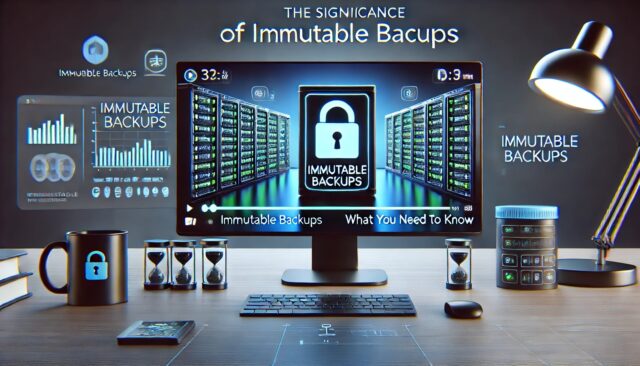There is literally no more critical component of consumer trust or client safety where enterprise companies need to manage people’s data and files carefully.
Data loss may have enormous financial, legal, and ethical implications for big organizations. Conventional backups are quite effective methods, so they should be used with others. Rather, the backup process requires reinforcement to make your data safer and untouchable. These data buffers are called immutable backup storage.
What Do Immutable Backups Mean?
As with any backup, you first need to understand what an immutable backup is. Immutable means incapable of being changed or destroyed. Immutable backups can usually only be deleted after a certain amount of time. This ensures the original integrity is maintained and protected because data cannot be modified or removed.
With the emergence of ransomware, maintaining an immutable backup has become vital for recovery. Threat actors regularly target backups nowadays, and an immutable backup protects this data from such attacks.
How Do Immutable Backups Work
When establishing an immutable backup, you apply an “object lock” on your data. That lock prevents anyone from mistakenly or purposefully modifying or destroying the data for a set period, usually determined by the user who creates the backup. While unchangeable, the data is classified as WORM-protected. It was once saved, the material can be viewed unlimited times but cannot be written over.
After the time period ends, it will release the object lock, and your backup is no longer immutable. Although you can technically create an immutable backup and let it remain unaltered for as long as required, mine data will eventually reach the point of usefulness in every organization.
The Significance of Immutable Backups
The most immediate risk to any organization is a ransomware attack. Ransomware can appear out of nowhere and hit any internet-accessible device in your environment, then propagate throughout the rest. A single attack can shut down a business, taking valuable time and real money to fix. This is further compounded by the heavy use of network share techniques in enterprise computing, which makes spreading malware trivial once someone breaks into any system connected to your network.
Traditional data backups will not work due to the possibility that your backup is also encrypted or just deleted in an attack. However, we are seeing ransomware attacks that attack the backups directly. So, how can you ensure that your backup data is not secure?
Primary storage systems should be open and approachable to client system traffic, while your backup data is isolated and immutable. This is the only way to guarantee recovery if production systems get compromised. Immutable backups cannot become infected by ransomware again.
It is not just a matter of file permissions or folder ACLs being set properly in the right place and sharing protocols being turned on. These protocols are not foolproof, and because there can always be ways these security measures could be bypassed, immutability has to be incorporated into the core of your backup architecture rather than being a simple add-on.
Built-in immutable data storage allows you to protect yourself from ransomware attacks by ensuring that one of the backups is always immutable. This capability provides a better chance for recovery, which can occur by restoring an unaffected version. By keeping immutable backups, you can restore your data after a ransomware infection and avoid paying the ransom.
Finally, an immutable backup protects against the corruption of your data by bad actors in the event that they gain access to some aspect of your environment. This allows you to remain compliant with regulatory data compliance stipulations and maintain ‘clean copies’ elsewhere.
What Are the Benefits of Immutable Backups?
Immutable backups have several benefits beyond ransomware resiliency:
- Make it tougher to lose data due to equipment failure or human error
- Fight against ransomware, malware, viruses, and other threats
- Recover files more quickly and confidently following an attack or natural disaster
- Gain peace of mind by better-preventing risks from internal or external bad actors
- Prevent unauthorized alterations to data
- Maintain data for legal or compliance needs
- Supply a chain of custody
- Secure digital evidence
Immutable Backup Management Best Practices
The best practices that you can follow to utilize immutable backups within your organization better are:
Regular Backup Scheduling
One of the most critical components of maintaining immutable backups is ensuring that backups are performed regularly. This is because the data in an immutable backup represents a snapshot of the data at a specific point in time. If backups are not routinely taken, the data may become outdated and no longer accurately reflect the system’s current condition.
One thing to note is how often backups get done, which will vary depending on the specifics of an organization. For others, daily backups do the trick. Others may need to do it more often, especially if they have a lot of data or changes frequently.
Retention Policy Management
Another significant element of immutable backup handling is retention-policy management. It is essential to control and govern how long those backups should be retained because there is data on them to which no one will have access, so we can only alter that or delete them once the amount of time goes beyond.
How long backups should be kept will vary depending on several factors, such as the type of data in general, regulatory requirements, and the amount of risk an organization is willing to take. But in a general sense, and if backups are secured, they should not be longer than however long it might take to restore the system from scratch due to data loss.
Test Restore Processes Regularly
Another best practice for dealing with immutable backups is performing regular tests of the restore processes. Since data in an immutable backup is the state of that particular point, it becomes critical to be able to restore it immediately.
Testing restore processes entails simulated data restoration from the backup and ensuring that the restored data is correct and extensive. This procedure should be repeated regularly to ensure that the restore process is functioning properly and to identify any possible issues before they become a problem.
Another concern about securing immutable backups is the security surrounding those encryption keys. When the keys used for encrypting said data are lost or exposed, the data can become so insecure that it becomes almost impossible to access it.
Conclusion
Implementing immutable backups is critical for protecting company data from ransomware and ensuring regulatory compliance. Immutable backup blocks, edits, or deletions for a predetermined period, assuring data integrity and recovery following intrusions.
Furthermore, immutable backups allow enterprises to secure their data, maintain consumer confidence, and prevent the terrible implications of data loss.














